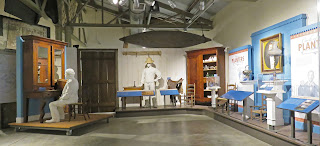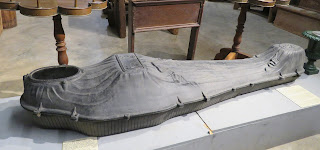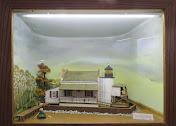Wednesday, December 28, 2022
West Baton Rouge Museum
The museum consists of several small exhibit galleries featuring permanent and changing exhibits. The centerpiece is a 33-foot model of a sugar mill, originally constructed for the 1904 Louisiana Purchase Exposition in St. Louis. There's also a short film shown on request. Seven historic buildings, which can be seen by guided tour only, have been relocated to the grounds. Three of the buildings are cabins furnished to represent how rural Black people lived during times of slavery; reconstruction and Jim Crow; and the 1950s and 60s. The Aillet House is a typical Creole style sugar plantation house. An army surplus building has been repurposed to represent a juke joint. The Arbroth Store, closed in 1980 after operating for 100 years, is stocked with goods that would have been sold from the early to mid 1900s. This museum has excellent wheelchair access. A ramped entrance can be accessed from the 6th Street parking lot. There's also a ramp at the main entrance that allows access to one gallery which otherwise could not be seen without navigating a few steps, The museum exhibit galleries are accessible. The walkways between the relocated buildings are all in very good condition. All of the buildings have ramps at the rear entrances.The parking lots are only large enough for vans and short RVs. Large RVs can be parked on North Jefferson Ave. Museum 30.4605, -91.20692
Thursday, December 22, 2022
Rural Life Museum
The main exhibits in the museum, both in the visitor center and on the grounds, center around life on sugar plantations in the 19th century. Excellent exhibits in the visitor center describe the lives of owners, overseers, and the slaves who were forced to work long and hard hours to grow, tend, and process the cane into sugar. The buildings on the grounds positioned to form an example of a working plantation, include the overseers house, rows of slave cabins, outbuildings, and a sugar house. The museum also has an assorted collection of tools, toys, household items, carriages including several hearses, and usual cast iron caskets. Buildings on the grounds are grouped together to represent an Arcadian settlement and life on pioneer farms. There's also a statue of an elderly black man that stood in the center of Natchitoches, Louisiana until 1968 when it was removed because of its racist depiction of a "good darkie" avoiding eye contact as he tips his hat. For years the original plaque was covered with a wooden box but that has been removed and a sign erected to explain the reason for the statue in the first place and the reasons it was removed and why it now stands on the museum grounds.
The museum also has an assorted collection of tools, toys, household items, carriages including several hearses, and usual cast iron caskets. Buildings on the grounds are grouped together to represent an Arcadian settlement and life on pioneer farms. There's also a statue of an elderly black man that stood in the center of Natchitoches, Louisiana until 1968 when it was removed because of its racist depiction of a "good darkie" avoiding eye contact as he tips his hat. For years the original plaque was covered with a wooden box but that has been removed and a sign erected to explain the reason for the statue in the first place and the reasons it was removed and why it now stands on the museum grounds.
 The museum also has an assorted collection of tools, toys, household items, carriages including several hearses, and usual cast iron caskets. Buildings on the grounds are grouped together to represent an Arcadian settlement and life on pioneer farms.
The museum also has an assorted collection of tools, toys, household items, carriages including several hearses, and usual cast iron caskets. Buildings on the grounds are grouped together to represent an Arcadian settlement and life on pioneer farms. The visitor center is accessible. The buildings on the grounds do not have ramps. It's possible to peek in the doors of some of the slave cabins. The ground is rough grass and difficult to push through without assistance.
To get to the museum follow the directions on the website as your GPS may lead you astray. The parking lot is large enough for any RV. The accessible spots are not long enough for RVs but park as close as possible to avoid the rough gravel of the parking lot. Museum 30.41193, -91.11633
Thursday, December 15, 2022
Lake Pontchartrain Basin Maritime Museum
The museum is located south of Madisonville, Louisiana where the Jahncke Shipyard once stood. The shipyard was established in 1900 and won a contact in 1917 from the US Navy to build six wooden-hulled ships. Part of the contact included painting the hulls with a razzle dazzle pattern. This was a form of camouflage with highly contrasting colors, not to hide the ships but to make it hard for German submarine commanders to estimate a target's range, speed, and heading. A very detailed diorama gives visitors a birds eye view of the shipyard during this time period. Lake Pontchartrain has a connection to the Gulf of Mexico through Rigolet's Strait so it's not really a lake but a saltwater estuary. The
strait allowed ships built in the towns along the shore to sail out to
the ocean. It also allowed the exportation of goods such as lumber,
charcoal, bricks, shells, cotton, and oysters. Exhibits in the museum cover life on the bayou; the steamboat era on the lake; the Pioneer, an experimental submarine built in 1862 and tested in Lake Pontchartrain; lighthouses in Louisiana; and the recovery of a Spanish ship that wrecked in the Gulf of Mexico in 1766. The museum is mostly accessible. A couple of videos have buttons that are too high. A mock-up of a river pilot's wheelhouse is accessed by steps only. The wooden boardwalk along the steamboat has a dangerously steep ramp at one end. The ramp at the other end is not as steep but use caution. The parking lot is large enough for any RV. Museum 30.39824, -90.15637
Tuesday, December 13, 2022
Fairview-Riverside State Park
 From the 1880s until the early 1930s, the park property was part of a sawmill community. A large house built by the first mill owner, W.T, Jay in 1885, is the only building still standing. It's usually open for tours but is closed until the damage from recent storms can be repaired. Visitors can walk along the property outside the white picket fence and also read about the steam engine that powered the mill.
From the 1880s until the early 1930s, the park property was part of a sawmill community. A large house built by the first mill owner, W.T, Jay in 1885, is the only building still standing. It's usually open for tours but is closed until the damage from recent storms can be repaired. Visitors can walk along the property outside the white picket fence and also read about the steam engine that powered the mill. Saturday, December 10, 2022
Big Biloxi Recreation Area
The campground has 25 sites, all with electricity and water. A dump station is located opposite the check-in booth. This is a national forest site and America the Beautiful passes are good for a discount of 35% instead of the standard 50%. - no explanation for that. Amenities include tables, fire rings, restrooms, and showers.
The main loop, which is on the perimeter of a large field, has widely spaced sites with little shade. The weather was cool so we camped in the main loop. The other loops are shady with more vegetation.
The site we chose isn't accessible but it is usable. Most of the other sites are usable. Several are supposed to be accessible so I assume the picnic tables have extended tops and the parking pads are larger but I didn't check them out.The sites in the main loop are large enough for any RV. Campground 30.56861, -89.12989
Subscribe to:
Posts (Atom)
















































